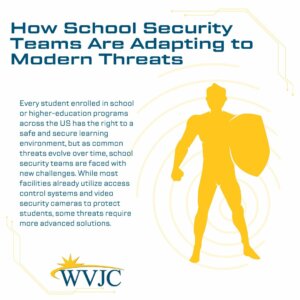
Every student enrolled in school or higher-education programs across the US has the right to a safe and secure learning environment, but as common threats evolve over time, school security teams are faced with new challenges. While most facilities already utilize access control systems and video security cameras to protect students, some threats require more advanced solutions.
Recently published data reveals as many as 98% of US schools operate some form of access control, with 91% using CCTV cameras to monitor threats. But with only 65% of modern schools employing one or more security officers, detecting and addressing incidents can be challenging.
Thankfully, school security technology has improved dramatically in recent years, enabling staff from facilities of all sizes to make use of smart technology solutions. From AI-informed software to remote-access management platforms, novel tools allow teams to make more efficient use of potentially limited resources. This is how school security teams are adapting to modern threats.
Cloud-based security management
The cornerstone of modern school security systems is often a well-implemented cloud-based security management platform. While in the past, security teams may have been restricted to viewing and operating installed devices from a fixed location, the deployment of cloud-based management systems enables even the smallest teams to detect threats much more efficiently.
Cloud-based systems work by combining the controls for all installed security devices, including cameras, access control readers, and alarms, within one integrated platform, allowing admins to access and adjust individual devices simultaneously. This provides staff with a holistic view of school security to ensure on-site teams are made aware of any potential threats as quickly as possible.
The main benefit, however, is that cloud-based management platforms can be accessed by staff remotely, with admins able to view and adjust systems from any verified smart device connected to a secure Wi-Fi network. This means security officers can receive real-time alerts in response to detected threats, alleviating anxieties by allowing staff to provide instant responses to threats.
Automated incident responses
With a cloud-based management system in place, modern school security teams are able to develop unique integrations designed to improve on-site security. For example, alarm systems can be connected to access control locks and programmed to activate in response to attempted break-ins, with staff notified remotely and able to view nearby cameras for further investigation.
Automated responses can also be developed to address modern threats, specifically through the use of Internet of Things (IoT) devices. IoT sensors are used to detect the presence of specific stimuli, with common hardware including sound, motion, heat, and pressure sensors.
IoT sensors can trigger immediate incident responses when integrated with wider security devices. For instance, IoT noise sensors can be programmed to activate alarms and access control locks if sounds consistent with a break-in are detected. Bespoke systems can be created to address the unique needs of individual facilities, enabling teams to address modern threats.
AI-informed video security
Video security systems have long been an integral part of an effective security system, allowing security teams to assess potential threats visually. However, traditional systems require at least one member of staff to manually review footage in search of suspicious activity, representing an inefficient system that also negatively impacts the physical presence of on-site security teams.
To address this issue, many schools and colleges choose to operate school CCTV systems featuring AI software integrations designed to detect a wide variety of potential threats autonomously. AI tools can continuously assess key locations in order to learn how facilities are commonly used, with the software then programmed to notify teams of anomalous events.
Rather than losing a security staff member to manual monitoring duties, AI software can be programmed to autonomously detect modern threats, including contraband items, crowds forming in unusual areas, and potential intruders in high-security locations like student housing or server rooms. Teams can then be notified remotely to provide a response.
Cybersecurity solutions
Alongside intelligent physical security measures, modern schools must be well-prepared to address sophisticated cyber threats, especially with the amount of sensitive student information that educators are required to store within internal databases appropriately. Additionally, online students must be protected from cyber attacks when accessing necessary learning applications.
In most cases, security teams will apply end-to-end encryption to all data transmissions sent via school communications systems, ensuring all sensitive data remains unreadable to hackers. In addition, campus security teams often adopt a zero-trust policy regarding access to sensitive digital systems, whereby users are asked to verify their permissions to access data continually.
Aside from software solutions, school security teams must ensure all staff and students receive frequent training in cybersecurity best practices, with this of particular importance considering 74% of data breaches involve an element of human error. Cyber attacks constantly evolve, so cybersecurity training must be performed frequently to ensure schools remain secure.
Summary
Security has always been a top priority for campus security teams and school administrators, though as the threats that schools face continue to evolve, staff must commit to updating their responses. By developing smart security systems designed to benefit from remote-access tools and intelligent software, teams can utilize automated responses and advanced preventative
